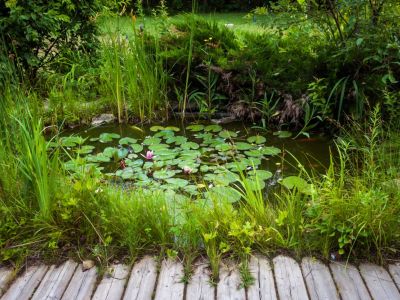What are Oxygenating Plants?
Submerged water plants are also known as oxygenating pond plants because they actually filter the pond water. Submerged plants also keep algae growth under control and provide oxygen. Submerged plants grow fully immersed in water and get their nutrients from the water through their leaves, not their roots like other plants. Plants that grow completely under water provide shelter for fish, oxygen to the water, and filter out pollutants.
Common Submerged Water Plants
Here is a small listing for some popular oxygenating pond plants commonly added to these aquatic environments:
American Pondweed – perennial plant with both floating and submerged leaves Bushy Pondweed – annual plant with dark green to greenish purple, ribbon-like leaves and forms dense stands Hornwort – Hornwort, sometimes called coontail, is a dark olive-green, rootless perennial plant that grows in dense colonies Eelgrass – also called tapegrass or wild celery, a rooted submerged plant that performs well in flowing water and has thin, ribbon-like leaves that resemble celery Egeria – produces dark green lance-like leaves in whorls that become dense near the tips Elodea – Elodea is a multi-branched perennial with dark green blade-like leaves and white, waxy flowers that float across the water, perfect for preventing algae Parrotfeather – Parrotfeather is a submerged perennial plant usually grown in shallow water, has gray-green thickly bunched and frilly divisions for a feather-like appearance Water Stargrass – grass-like with thin branching dark-green stems that can grow up to 6 feet (2 m.) and forms floating colonies, bright yellow flowers Cabomba – Cabomba is a subtropical plant with bright green fan-like leaves and lovely white flowers on the water’s surface
How to Plant Submerged Plants
One bunch of submersed water plants per one square foot (929 sq. cm.) of water surface will keep the water clean and oxygenated whenever these oxygenating pond plants are added to a water garden. They are generally placed in pots and positioned in shallow water or placed 1 to 2 feet (31-61 cm.) below the water surface. Submerged plants can also be held down under water with heavy rocks. If you pot your plants, be sure to use a heavy garden soil, a pot without drainage holes, and cover the soil with gravel so that it does not escape. Depending on the variety of your submerged water plants, a slow release fertilizer may be required for optimal growth. Also, if you live in a cold climate, you may have to overwinter your submerged plants. NOTE: The use of native plants in a home water garden (referred to as wild harvesting) can be risky if you have fish in your pond, as most natural water features are host to a plethora of parasites. Any plants taken from a natural water source should be quarantined overnight in a strong solution of potassium permanganate to kill any parasites prior to introducing them into your pond. That being said, it is always best to obtain water garden plants from a reputable nursery.
